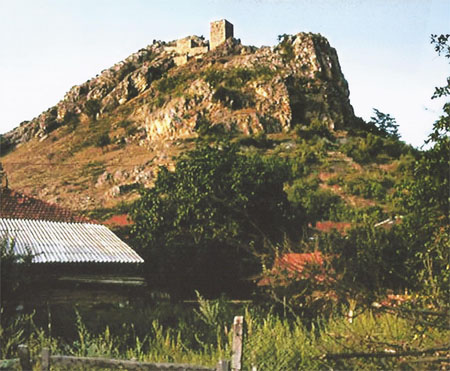Grad near Delčevo
Kiril Trajkovski
Grad is the present-day name of a village situated 6 km southeast of the administrative centre Pijanec in Delčevo and several kilometers from the border with Bulgaria. The name of the village speaks of the existence of an urban settlement in the past, whose significance and prosperity came from its proximity to the rivers Struma and Vardar which served as communication routes between civilizations.
A high rocky hill called Grado rises over the northeast side of the village and the small river Pijavica flows by its north and east sides. Today, near it, stands part of the ethno park with several architectural structures. A huge cave with traces of prehistoric life is naturally carved in the cavern opposite the site of Grado.
Around 3,000 BC, the inhabitants of this site led a calm and idyllic life: the numerous surviving ceramic vessels of high artistic value testify to this fact. Grad acquired the features of an urban settlement in Late Antiquity or in the period between the 4th and 6th centuries. At that time, the hill was surrounded with ramparts and towers which guaranteed the safety of its inhabitants. Situated in the vicinity of the Antique road, the city, having a strategic purpose as well, controlled the region until the late 6th century, when life outside it ceased, as the consequence of barbaric raids from the north and plague epidemics.
More than 300 years the site of Grado was not the focus of interest of the people who, at that time, were experiencing the darkest period of the Middle Ages. These conditions persisted until the 11th century, when the citadel was gradually renewed, as well as the suburbium, which survive only in fragments. The highest elevation point of the hill was the site of the towers which guaranteed the security of both the city administration and the citizens. The metal objects that have been discovered on this site, among which the largest number belongs to tools, weapons and coins, are silent witnesses to the history of a Byzantine town which pulsated with life as late as until the early 14th century. Venetian merchants were its most frequent visitors in the 13th and 14th centuries, and their silver coins have been unearthed in the layers of this site. In the 14th century, the activities in the district of Pijanec were probably administered and coordinated from this site, until the death of Prince Dragaš in 1395, when the Ottoman rule of five hundred years formally began, followed by the decline during which the urban settlement of Grad became a village.
